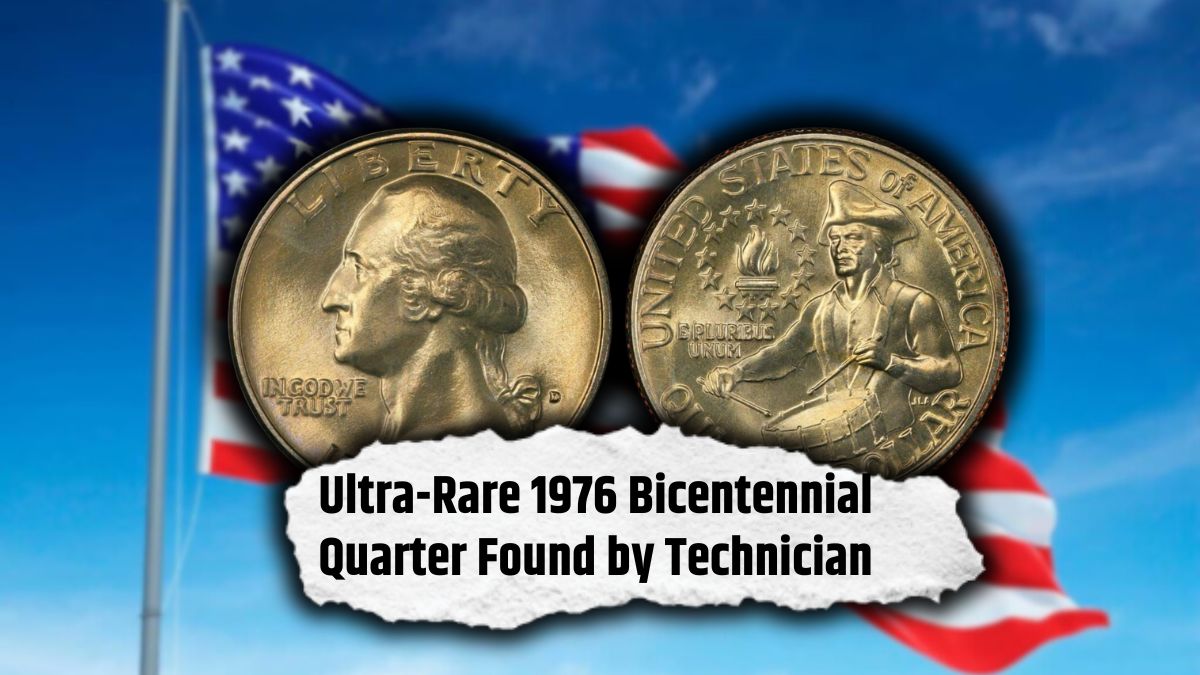A routine workday became a life-changing moment for an Oklahoma vending machine technician after he discovered a rare 1976 Bicentennial quarter — now valued at $4.61 million. Found during a routine service check, this single coin transformed a standard task into a once-in-a-lifetime treasure hunt, underscoring the hidden value that may lie unnoticed in everyday change.
Why This 1976 Bicentennial Quarter Is Exceptionally Rare
Though millions of Bicentennial quarters were issued to commemorate America’s 200th birthday, the coin found by the technician, identified only as Wright, is extraordinarily rare due to several unique factors:
- It was struck as a proof coin, meaning it was specially minted for collectors with a high-gloss, mirror-like finish.
- It was minted in 90% silver, unlike most Bicentennial quarters which are composed of copper-nickel.
- It was struck on a planchet meant for another denomination — a mint error that significantly increases rarity and value.
After professional grading by the Professional Coin Grading Service (PCGS), the coin received a PR70 Deep Cameo rating — the highest possible grade, confirming it as virtually flawless.
How a Single Coin Was Valued at $4.61 Million
The combination of historical significance, minting error, and perfect condition sparked intense interest in the numismatic community. Within days of its verification, the coin was purchased by a private collector known for acquiring ultra-rare mint errors and high-grade proofs.
Mark Sutton, the coin dealer who brokered the deal, noted, “This is the ultimate Bicentennial quarter — flawless, rare, and with an unbelievable origin story. Coins like this rarely enter the public market, let alone from something as routine as a vending machine.”
The Legacy of Bicentennial Quarters
The Bicentennial quarter, issued between 1975 and 1976, celebrates the 200th anniversary of American independence. It features a distinctive reverse design — a colonial drummer with the dual date “1776–1976” — making it one of the most recognizable coins in U.S. history.
While hundreds of millions were circulated and most hold only face value, certain collector versions and error coins are extremely valuable, such as:
- Silver proof sets designed for collectors
- Off-metal strikes, where coins are minted on the wrong metal blanks
- Double-die or misstruck varieties, which show irregularities during production
These rare varieties often fetch thousands to millions of dollars, depending on their condition and scarcity.
A Life-Changing Moment for a Working Man
For Wright, this discovery was more than just a collector’s dream — it was a life-altering moment.
“I’ve been fixing vending machines for 17 years and never imagined this kind of thing could happen,” Wright said. “It feels like winning the lottery, but with a coin instead of a ticket.”
He plans to use the proceeds to:
- Pay off personal and family debts
- Start an investment portfolio
- Take his family on their first overseas vacation
A Wake-Up Call for Coin Collectors and the Curious
Wright’s experience serves as a compelling reminder: valuable coins still exist in circulation, and they can appear in the most unexpected places — in your change, inside a coin jar, or in a vending machine.
If you ever come across a Bicentennial quarter that looks unusually bright, sharply detailed, or heavier than normal, it might be worth having it professionally appraised. Even if it looks like any other quarter, subtle differences can translate into major value.
Other Modern Coin Discoveries Worth Thousands — or More
This isn’t the only instance where ordinary coins turned out to be extraordinary treasures. In recent years, collectors have uncovered:
- A Lincoln Wheat Penny worth over $3.12 million, still potentially in circulation
- A Roosevelt Dime with no mint mark valued at over $300,000
- 2017 $1 bills with special serial numbers fetching up to $60,000
Each of these discoveries proves one thing — numismatic treasures are still out there.
How to Spot Rare Coins in Your Own Change
Inspired to check your own coins? Here are a few expert tips for identifying potentially valuable finds:
1. Look for Proof-Like Qualities
Proof coins have a mirror finish and crisp details. Even if they appear in circulation, they’ll often stand out visually.
2. Weigh the Coin
Normal quarters weigh around 5.67 grams. If your coin feels off, it may have been struck on an incorrect planchet — a valuable mint error.
3. Inspect for Mint Errors
Common errors include:
- Double-die strikes
- Off-center designs
- No mint marks where one should be
4. Get It Professionally Graded
Use trusted services like PCGS or NGC to verify authenticity and determine condition.
5. Never Clean the Coin
Cleaning a rare coin can damage its surface and drastically reduce its value. Always keep it in its original condition.
Final Thoughts: Could You Be Holding a Million-Dollar Coin?
Wright’s story isn’t just an isolated incident — it’s a reminder that everyday objects can hold immense value. The next time you receive change, take a closer look. That old quarter might just be your ticket to a life-changing discovery.
FAQs
Q1: Are all Bicentennial quarters valuable?
No. Most are worth just 25 cents, but proofs, silver versions, and mint errors can be highly valuable.
Q2: How do I know if my coin is rare?
Look for unusual features, mirror finishes, weight discrepancies, or striking errors. Have it graded for confirmation.
Q3: Should I clean my coin before appraisal or sale?
Absolutely not. Cleaning can decrease its value. Leave it in its found condition and handle with care.









